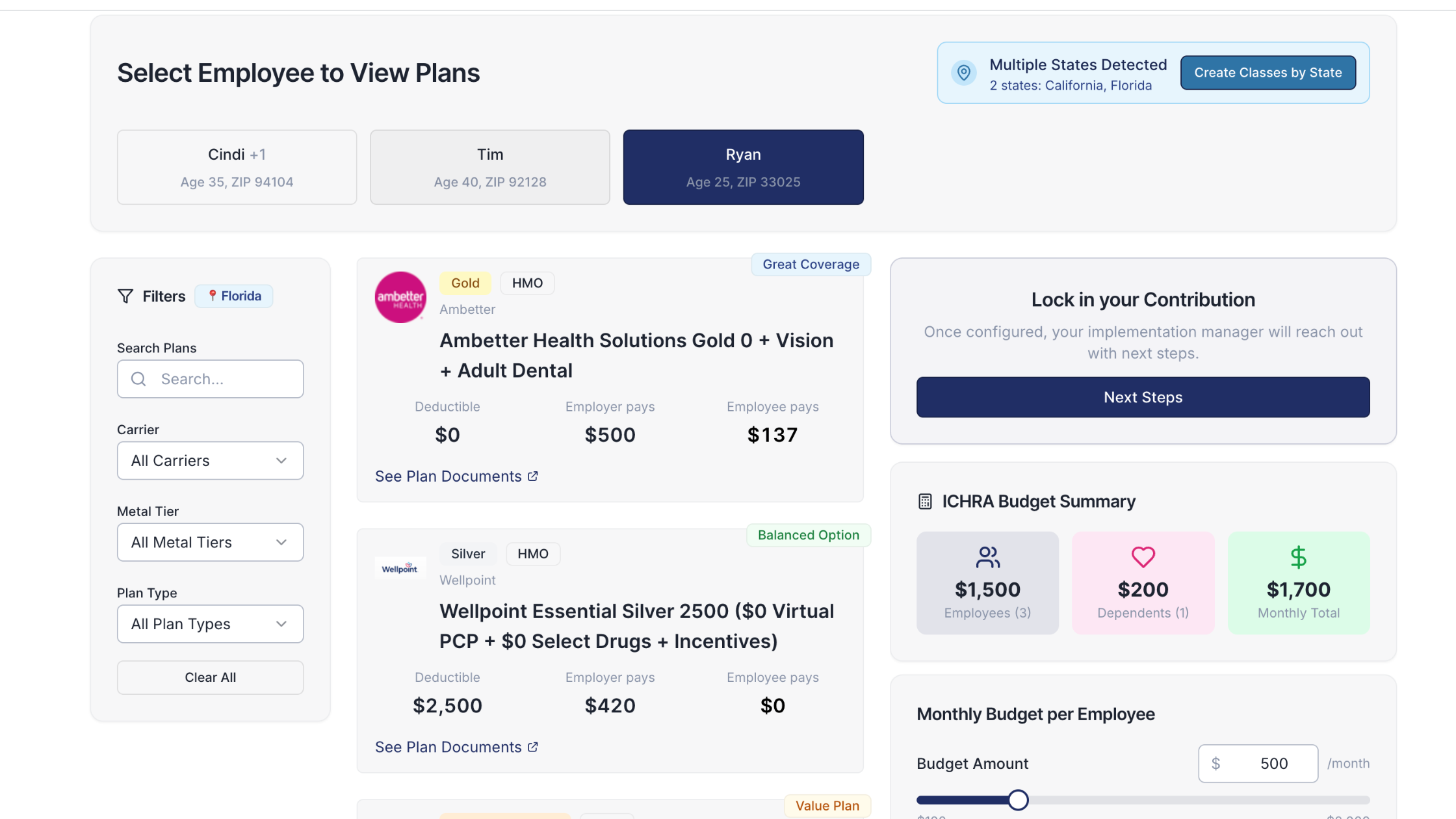2026 ACA Marketplace Changes: How On- and Off-Exchange Plans Are Affected

The 2026 ACA Marketplace is set for some of the most significant changes since the Affordable Care Act (ACA) began reshaping American health insurance. These updates will impact both on-exchange and off-exchange plans—affecting eligibility, enrollment, subsidies, premiums, and out-of-pocket costs. For benefits professionals and company leaders responsible for employee health plans, understanding these shifts is key to making smart decisions and supporting clients or workforces through the transition.
What’s Changing in the 2026 ACA Marketplace?
The Centers for Medicare & Medicaid Services (CMS) has finalized new rules for 2026 that will reshape how health insurance works for millions of Americans. These changes touch on everything from who can enroll to how much people pay for coverage, and they are designed to make the Marketplace more transparent, secure, and efficient.
Some of the most notable changes include:
- Stricter Enrollment and Eligibility Checks: New rules will require more documentation to prove eligibility for special enrollment periods and subsidies. This is meant to reduce fraud and ensure that only those who qualify receive financial assistance.
- Changes to Subsidies: The enhanced premium tax credits (PTC) from the American Rescue Plan Act and Inflation Reduction Act are set to expire at the end of 2025 unless Congress renews them. If they expire, most Marketplace enrollees will see higher net premiums and out-of-pocket costs in 2026.
- Risk Adjustment Updates: CMS has recalibrated the risk adjustment models for 2026, including new factors like HIV PrEP drugs as a distinct risk and phasing out adjustments for Hepatitis C drugs.
- Plan Selection and Transparency: The 2026 rules make it easier for consumers to understand their costs and enroll in coverage through HealthCare.gov.
- Maximum Out-of-Pocket Limits: The maximum out-of-pocket limits for 2026 plans will increase, meaning consumers could pay more before their insurance fully kicks in.
On-Exchange vs. Off-Exchange Plans: What’s the Difference?
Before diving deeper into the 2026 changes, it’s important to clarify the difference between on-exchange and off-exchange plans.
- On-Exchange Plans: These are health insurance plans sold through the official ACA Marketplace (like HealthCare.gov or state-run exchanges). Only on-exchange plans are eligible for premium tax credits and cost-sharing reductions, which can make coverage much more affordable for eligible individuals and families.
- Off-Exchange Plans: These are ACA-compliant plans sold directly by insurers or brokers, outside the Marketplace. Off-exchange plans do not qualify for federal subsidies, but they often offer more flexibility and choice in coverage options.
How 2026 Changes Affect On-Exchange Plans
The 2026 ACA Marketplace changes will have a big impact on on-exchange plans and the people who use them.
Eligibility and Enrollment
- Tighter Verification: Starting in 2026, people enrolling in Marketplace plans will face more robust documentation requirements. This includes proof of eligibility for special enrollment periods and additional income verification for subsidies.
- Shorter Open Enrollment: The open enrollment period will be shorter in all states. This means less time to shop for and select a plan.
- No Auto-Renewal for $0 Premium Plans: Enrollees who currently have $0-premium plans will no longer be able to auto-renew. They will need to actively choose a plan or risk losing coverage.
- Maximum Out-of-Pocket Limits: The maximum out-of-pocket limits for on-exchange plans will increase in 2026, meaning consumers could pay more before reaching their plan’s coverage cap.
Subsidies and Premiums
- End of Enhanced Subsidies: Unless Congress acts, the enhanced premium tax credits will expire at the end of 2025. This means most enrollees will see their net premiums rise by an average of over 75% in 2026.
- Premium Payment Flexibility: Insurers will have more options for setting thresholds on premium payments, helping to reduce coverage terminations for people who underpay by a small amount.
Plan Design and Risk Adjustment
- Risk Adjustment Changes: CMS has updated the risk adjustment models to better reflect the health needs of enrollees, including adding HIV PrEP drugs as a distinct risk factor.
- Plan Generosity: Insurers may offer less generous plans with higher out-of-pocket costs, but this could also mean lower premiums for some enrollees who do not qualify for subsidies.
How 2026 Changes Affect Off-Exchange Plans
Off-exchange plans are not directly involved in the Marketplace, but the 2026 changes will still have ripple effects.
- No Subsidy Eligibility: Off-exchange plans remain ineligible for premium tax credits or cost-sharing reductions, regardless of the changes to the Marketplace.
- Premium and Out-of-Pocket Trends: As on-exchange premiums rise due to the end of enhanced subsidies, some healthier individuals—especially those ineligible for subsidies—may shift to off-exchange plans. This migration is expected to improve the risk profile of off-exchange plans, particularly those offered through employer groups.
- Plan Flexibility: Off-exchange plans often offer more flexibility in coverage options and provider networks, which could become more attractive as on-exchange plans become less generous or more expensive.
- Broker and Employer Impact: Benefits brokers and employers may see increased interest in off-exchange options from employees or clients looking for alternatives to rising Marketplace costs.
What Benefits Brokers and Employers Need to Know
For benefits brokers and company leaders, the 2026 ACA Marketplace changes mean it’s time to get proactive.
- Stay Informed: Keep up with the latest CMS rules and deadlines. Changes to eligibility, enrollment, and subsidies will require clear communication with clients and employees.
- Help Navigate Subsidy Changes: With the end of enhanced premium tax credits, many enrollees will need help understanding their new costs and options. Brokers and HR teams can provide critical guidance.
- Plan Selection Support: The shorter open enrollment period and new documentation requirements mean enrollees will need more support to complete applications and choose the right plan.
- Monitor Off-Exchange Trends: As some enrollees move to off-exchange plans, brokers and employers should be ready to discuss these options and their pros and cons.
- Compliance and Risk Adjustment: Stay on top of changes to risk adjustment models and ensure that any employer-sponsored plans remain compliant with ACA requirements.
Key Takeaways for 2026
- On-exchange plans will see major changes to eligibility, enrollment, subsidies, and out-of-pocket costs in 2026.
- Off-exchange plans remain ineligible for subsidies but may become more attractive as Marketplace costs rise.
- Benefits brokers and employers play a crucial role in helping clients and employees navigate these changes.
Final Thoughts
The 2026 ACA Marketplace changes are some of the most significant in years, and they will affect both on-exchange and off-exchange plans. For benefits brokers, HR leaders, and business owners, staying informed and proactive will help ensure smooth transitions for clients and employees. By understanding the new rules around eligibility, enrollment, subsidies, and out-of-pocket costs, you can help people make the best choices for their health and financial well-being.
The ACA Marketplace remains a vital source of coverage for millions of Americans, and with the right guidance, the 2026 changes can be managed successfully. Whether you’re helping a large workforce or a single client, clear communication and expert support will make all the difference in navigating the new landscape of on-exchange and off-exchange health insurance.
You got questions, we got answers!
We're here to help you make informed decisions on health insurance for you and your family. Check out our FAQs or contact us if you have any additional questions.
The main changes include stricter eligibility and enrollment verification, the end of enhanced premium tax credits (unless renewed by Congress), higher maximum out-of-pocket limits, and updates to risk adjustment models.
Most Marketplace enrollees will see their net premiums increase by an average of over 75% if the enhanced subsidies are not extended.
No, only on-exchange plans are eligible for premium tax credits and cost-sharing reductions.
The exact 2026 amounts have not been finalized, but the limit is expected to increase from 2025 levels, meaning consumers could pay more before their insurance covers the full cost.
Yes, the open enrollment period will be shorter in all states for 2026.
You will need to provide documentation for any qualifying life event, and exchanges may verify eligibility for at least 75% of new enrollees using special enrollment periods.
Insurers will have more options for setting payment thresholds, but you still need to pay your premium to keep your coverage active.
The main focus is on reducing fraud, increasing transparency, and updating risk adjustment models. There are no major new benefits, but plans will continue to cover essential health benefits.
Small businesses and their employees may face higher premiums if they rely on Marketplace plans, but they can also explore off-exchange or employer-sponsored options.
You will need to select a new plan during open enrollment or a special enrollment period if you qualify.
Explore more related content
What is Venteur
Explore the best human-first Health Insurance platform
Simple, personalized health benefits
Sign up in minutes, define your contribution, and let your employees choose the health plan that works right for them
Integrations to make everything run smoothly
We'll connect with your payroll and finance systems to make deductions and premium payments seamless
Easy onboarding and off-boarding
In just a few clicks, add your roster and make updates on the fly. We'll handle it from there.
Venteur Certified Brokers to help your employees pick the right plan
Our trusted brokers ensure the best outcomes for employees and employers by unlocking health savings and providing unrivaled plan options.
AI-powered plan recommendations to give you confidence while you shop
Backed by 30 years of healthcare data, Venteur’s AI helps employees compare and choose the best plan for their unique situation.
Compliance and reporting because no-duh!
Venteur manages plan administration, reporting, and compliance so you can focus on growing your business.


